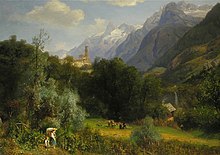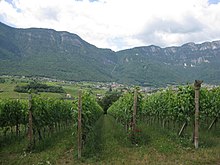South Tyrol (wine region)
| Data | |
|---|---|
| Wine region | South-Tirol |
| country | Italy |
| Viticulture since | around 1000 BC Chr. |
| Acreage | 5,400 ha |
| Yield | 330,000 hl |
| Share of quality wines | 98% |
| Website | www.suedtirolwein.com |
| map | |
The viticulture in South Tyrol has a long tradition that can be traced on the basis of evidence into pre-Roman times. As an Italian wine-growing region , South Tyrol has its own DOC regulations .
The very different climatic conditions in the various farming communities, together with the widely divergent altitudes (200- 1000 m ) allow a versatile wine-growing of many red and white grape varieties . There are two autochthonous grape varieties that are grown commercially in South Tyrol: Vernatsch and Lagrein . The Gewürztraminer , which is grown worldwide, owes its name to the wine village of Tramin .
Growing area
South Tyrol is a small, but multifaceted wine - growing region . In 2016, the entire wine-growing area comprised 5,400 ha, making South Tyrol one of the smallest Italian wine-growing regions (around 0.7% of the total area). 350,000 hl of DOC wine were produced. Many South Tyrolean locations are characterized by relatively mild climatic conditions, which extend in the Adige Valley ( Unterland , Überetsch , Bozen , Terlan , Burggrafenamt ) to Merano . The Vinschgau and Eisack Valley , on the other hand, are a bit rougher. The wine-growing area includes altitudes that range from 200 m to 1000 m above sea level.
South Tyrol has a high density of DOC wines, i.e. wines with a controlled designation of origin. The approx. 5,000 wine-growing companies in South Tyrol deliver their grapes to approx. 170 wineries . Around 70% of South Tyrolean wine is pressed in cooperatively managed cellars . Another 25% of the annual wine production comes from the association "South Tyrolean wineries" and the remaining 5% of the South Tyrolean wines come from the " Independent Winegrowers South Tyrol ".
The white grape varieties take up around 60% of the South Tyrolean wine-growing area. Ruländer , Gewürztraminer , Pinot Blanc and Chardonnay are the most frequently grown white wines in South Tyrol in terms of quantity . In addition to the two autochthonous grape varieties Vernatsch and Lagrein , Blauburgunder , Merlot and Cabernet Sauvignon in particular dominate the red wines . Red varieties take up about 40% of the total area under vines.
history

Finds of grape seeds from the Iron Age ( Stufels near Brixen) and archaeological excavations from around 400 BC. Chr. Suggest a viticulture 3000 years ago. The oldest sources of viticulture in the Alpine region come from the Romans via the wines of the time from Raetia . Marcus Porcius Cato emphasized Rhaetian wine in his work De agri cultura , even before this area was conquered by the Romans. According to Pliny , the Romans took over the storage and transport of wine in wooden barrels from the Councilors.
In 720 AD, Korbinian , the first bishop of Freising , commissioned the creation of vineyards in the burgrave office . Since the 12th century , records of the lively activities of the southern German monasteries and aristocrats have provided information about viticulture.
The cellar at South Tyrolean wine yards experienced a blooming phase in the end of the Middle Ages and in the Habsburg era (from 1363). The Tyrolean sovereigns protected the domestic cultivation areas and their export opportunities to the north with appropriate measures: Duke Leopold III. von Habsburg issued a ban on the import of Italian wines to South Tyrol as early as 1372 at the request of the Bolzano -oriented citizenship , which came from areas south of the Noce and Avisio ( “welsche wein vnder des Eveys” ). This policy of isolation was maintained for centuries.
In the 20th century there were several crises: first the appearance of phylloxera , then the First World War and the separation from the traditional markets (Austria-Hungary, Bavaria) with repression under fascism , followed by the Second World War . The wine industry was able to consolidate itself through mass production up until the 1980s. In the 1980s, a crisis of the then current marketing channels became acute in the South Tyrolean wine-growing, in particular the open wine sale in tanks to Switzerland collapsed. The wineries therefore changed their sales strategy . From then on, more quality wines were produced; the pure quantity thought took a back seat. Another decisive factor for viticulture in South Tyrol was the limitation and upgrading of the vineyards with the DOC regulation, which dates back to 1971. The quality production, which has been promoted since then, as well as the filling in the 0.75 l bottle increased the reputation of the wine-growing region considerably. This is especially true in Italy for white wines , but increasingly also on the international markets.
The South Tyrolean Wine Museum in Kaltern offers an overview of the history and traditional techniques of local viticulture .
DOC regulations
White , rosé and red wines as well as sparkling wines from the entire South Tyrolean wine-growing region can be marketed with the designation "Südtirol" ( Italian "Alto Adige") or "Südtiroler" ( Italian "dell'Alto Adige") if they comply with the DOC regulations. The following grape varieties are permitted:
|
|
If the name of a grape variety appears on the label next to the addition “Südtirol” or “Südtiroler”, at least 85% of the wine must have been made from the corresponding variety. In some defined cases, two grape varieties can also be specified. Regulated predicates there are Passito , Spätlese ( vendemmia tardiva ) and Riserva .
The wine-growing region of South Tyrol also contains seven DOC sub-regions, each with separate provisions: the "Südtirol Meraner" site is located around the city of Merano , and the vineyards of the "Südtirol Vinschgau" are further to the west. The cultivation area “South Tyrol Kalterersee” spreads out in the hilly landscape of the Überetsch and south of it, in the middle Adige Valley the “South Tyrol Terlaner”. In the Eisack Valley between Vahrn and Völs you will find the "Südtirol Eisacktaler", east of the city of Bozen the "Südtirol Bozner Leiten" and north of it the "Südtirol St. Magdalener ".
Cultivation
The South Tyrolean winegrowers win their grapes with environmentally friendly cultivation methods in the vineyards, often by handwork on steep slopes. The additional effort serves both quality and landscape protection . With so-called "integrated" viticulture , the South Tyrolean winemakers support the grapes' resistance, thus protecting beneficial organisms and promoting their spread. Strict yield limits and consistent conversion from the classic pergel to the modern wire frame upbringing increase the quality of the vine.
literature
Viticulture history
- Gotthard Andergassen: South Tyrolean viticulture and wine industry in the Middle Ages . In: Südtirol in Wort und Bild , 49/2005, pp. 7-14
- Matthias Ladurner-Parthanes : From Perglwerk to Torggl . Athesia, Bolzano 1972
- Ivo Maran, Stefan Morandell: Vernatscher, Traminer, Kalterersee wine. News from South Tyrol's wine history (= writings on wine history , no. 188). Society for the History of Wine , Wiesbaden 2015
- Josef Nössing: Bolzano's wine trade in the Middle Ages and in modern times. In: Ferdinand Opll (Ed.), Stadt und Wein , R. Trauner, Linz 1996, pp. 181–192
- Barbara Stocker: Wine and its history . In: Südtirol in Wort und Bild , 49/2005, pp. 1–6
- Herbert Taschler: South Tyrolean wine and cellar stories. From the glut of wine to the quality offensive - 41 cellar masters and wine pioneers talk . Athesia, Bozen 2017, ISBN 978-88-6839-300-7 .
- Roland Zwerger: From the Weißen Lagrein via the “Weißterlinger” to the Gewürztraminer. A short history of South Tyrolean varieties with a special focus on Tramin. In: Der Schlern , 79/2005, pp. 78–87
Guides
- Martin Kilchmann: Wines from South Tyrol . Müller Rüschlikon, Cham 1995, ISBN 3-275-01168-5
- Jens Priewe with the collaboration of Christoph Tscholl: The wines of South Tyrol. The guide for connoisseurs and bon vivants. Collection Rolf Heyne, Munich 2006, ISBN 3-89910-299-1
- Falstaff Wine Guide: Austria, South Tyrol . Falstaff-Verlag , Vienna (published annually)
- Vini d'Italia . Gambero Rosso , Rome (published annually)
Web links
- Official website of the South Tyrolean Wine Consortium
- DOC regulations for South Tyrol (PDF file in Italian)
- Winegrowing language in South Tyrol
Individual evidence
- ↑ Unmistakable: Lagrein and Vernatsch , on suedtirolwein.com, accessed in January 2020
- ↑ Viticulture in figures 2017. (PDF) In: VQPRD d'Italia 2017. federdoc.com, accessed on June 21, 2018 (Italian).
- ^ Consortium of South Tyrolean Wine, Viticulture in South Tyrol .
- ↑ Andreas Otto Weber: Studies on the viticulture of the old Bavarian monasteries in the Middle Ages: Old Bavaria, Austrian Danube region, South Tyrol. Stuttgart: Franz Steiner 1999. ISBN 978-3515072908
- ^ Hannes Obermair : Bozen Süd - Bolzano Nord. Written form and documentary tradition of the city of Bozen up to 1500 . tape 1 . City of Bozen, Bozen 2005, ISBN 88-901870-0-X , p. 381, no.793 (with illus. 40) .
- ↑ Disciplinare di Produzione (production regulations and description). (PDF) wineacts.it, accessed on July 21, 2020 (Italian, I vini italiani a Dop ea Igp ).
- ↑ My buying guide "Wines and winemakers from South Tyrol". Meininger 2005, p. 15



